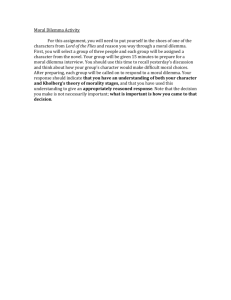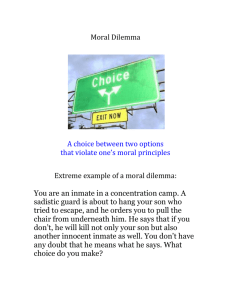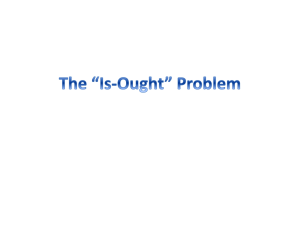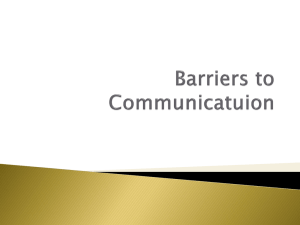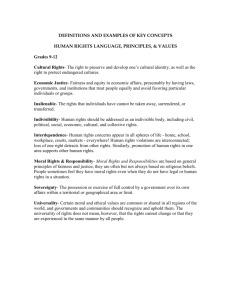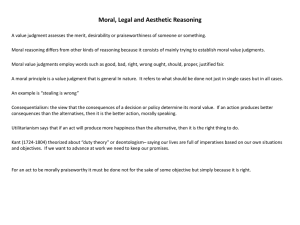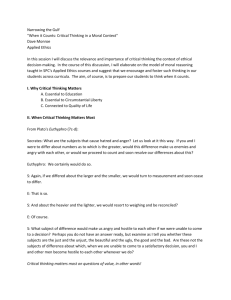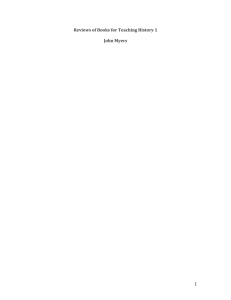exercise
advertisement
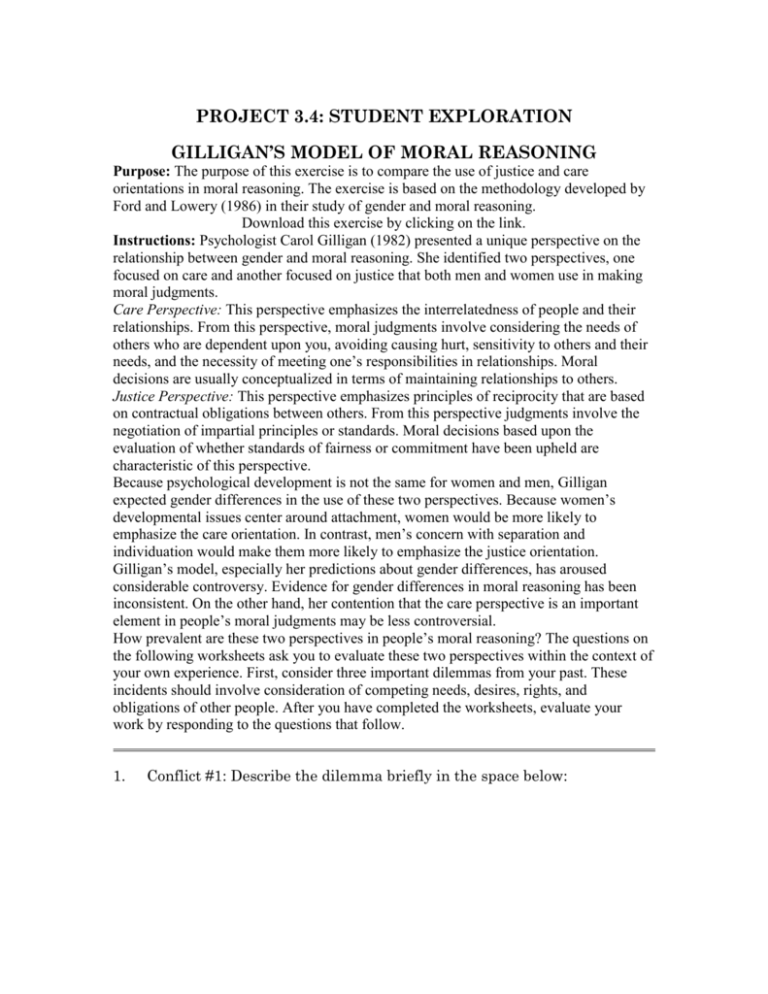
PROJECT 3.4: STUDENT EXPLORATION GILLIGAN’S MODEL OF MORAL REASONING Purpose: The purpose of this exercise is to compare the use of justice and care orientations in moral reasoning. The exercise is based on the methodology developed by Ford and Lowery (1986) in their study of gender and moral reasoning. Download this exercise by clicking on the link. Instructions: Psychologist Carol Gilligan (1982) presented a unique perspective on the relationship between gender and moral reasoning. She identified two perspectives, one focused on care and another focused on justice that both men and women use in making moral judgments. Care Perspective: This perspective emphasizes the interrelatedness of people and their relationships. From this perspective, moral judgments involve considering the needs of others who are dependent upon you, avoiding causing hurt, sensitivity to others and their needs, and the necessity of meeting one’s responsibilities in relationships. Moral decisions are usually conceptualized in terms of maintaining relationships to others. Justice Perspective: This perspective emphasizes principles of reciprocity that are based on contractual obligations between others. From this perspective judgments involve the negotiation of impartial principles or standards. Moral decisions based upon the evaluation of whether standards of fairness or commitment have been upheld are characteristic of this perspective. Because psychological development is not the same for women and men, Gilligan expected gender differences in the use of these two perspectives. Because women’s developmental issues center around attachment, women would be more likely to emphasize the care orientation. In contrast, men’s concern with separation and individuation would make them more likely to emphasize the justice orientation. Gilligan’s model, especially her predictions about gender differences, has aroused considerable controversy. Evidence for gender differences in moral reasoning has been inconsistent. On the other hand, her contention that the care perspective is an important element in people’s moral judgments may be less controversial. How prevalent are these two perspectives in people’s moral reasoning? The questions on the following worksheets ask you to evaluate these two perspectives within the context of your own experience. First, consider three important dilemmas from your past. These incidents should involve consideration of competing needs, desires, rights, and obligations of other people. After you have completed the worksheets, evaluate your work by responding to the questions that follow. 1. Conflict #1: Describe the dilemma briefly in the space below: 2. Approximately how old were you at the time? 3. How important did this dilemma seem to be at that time? (circle one) 1 Not at all important 4. 4 5 6 7 Extremely important 2 3 4 5 6 7 Extremely difficult To what extent did you utilize the care perspective in resolving this dilemma? (circle one) 1 Not at all 6. 3 How difficult was it for you to decide what to do? (circle one) 1 Not at all difficult 5. 2 2 3 4 5 6 7 A great deal To what extent did you utilize the justice perspective in resolving this dilemma? (circle one) 1 Not at all 2 3 4 5 6 7 A great deal 1. Conflict #2: Describe the dilemma briefly in the space below: 2. Approximately how old were you at the time? 3. How important did this dilemma seem to be at that time? (circle one) 1 Not at all important 4. 4 5 6 7 Extremely important 2 3 4 5 6 7 Extremely difficult To what extent did you utilize the care perspective in resolving this dilemma? (circle one) 1 Not at all 6. 3 How difficult was it for you to decide what to do? (circle one) 1 Not at all difficult 5. 2 2 3 4 5 6 7 A great deal To what extent did you utilize the justice perspective in resolving this dilemma? (circle one) 1 Not at all 2 3 4 5 6 7 A great deal 1. Conflict #3: Describe the dilemma briefly in the space below: 2. Approximately how old were you at the time? 3. How important did this dilemma seem to be at that time? (circle one) 1 Not at all important 4. 4 5 6 7 Extremely important 2 3 4 5 6 7 Extremely difficult To what extent did you utilize the care perspective in resolving this dilemma? (circle one) 1 Not at all 6. 3 How difficult was it for you to decide what to do? (circle one) 1 Not at all difficult 5. 2 2 3 4 5 6 7 A great deal To what extent did you utilize the justice perspective in resolving this dilemma? (circle one) 1 Not at all 2 3 4 5 6 7 A great deal 1. Did you use the justice perspective or the care perspective consistently? Was the justice perspective or the care perspective used in resolving some dilemmas but not others? 2. Were your importance and difficulty ratings related to the extent to which you utilized the care perspective? The justice perspective? 3. What do you think about the possibility of gender differences in moral reasoning? Do you think they might be related to gender roles, life stage, or age, for example? Support your conclusions by reference to your worksheets and to your text. References: Ford, Maureen R., & Lowery, Carol R. (1986). Gender differences in moral reasoning: A comparison of the use of justice and care orientations. Journal of Personality and Social Psychology, 50, 777–783. Gilligan, Carol (1982). In a different voice: Psychological theory and women’s development. Cambridge, MA: Harvard University Press.
